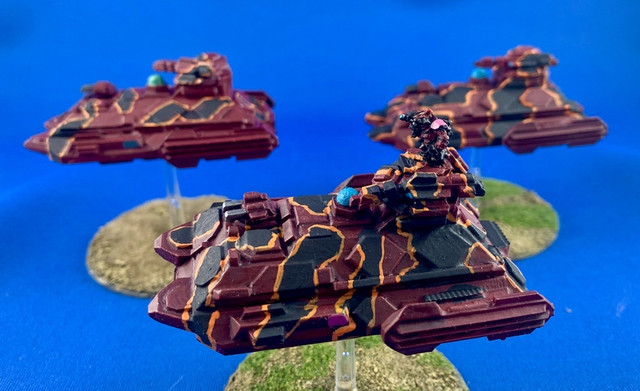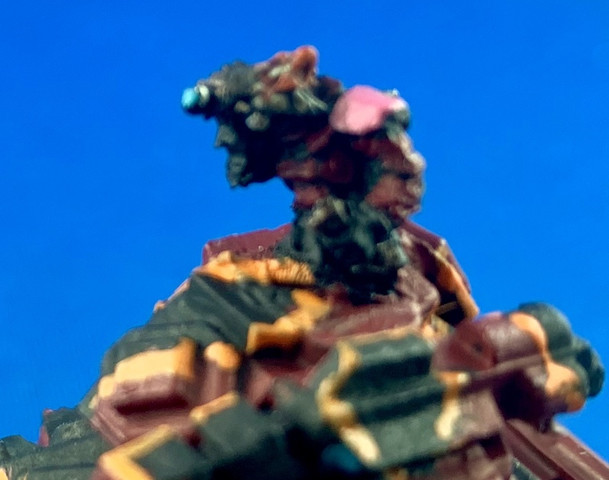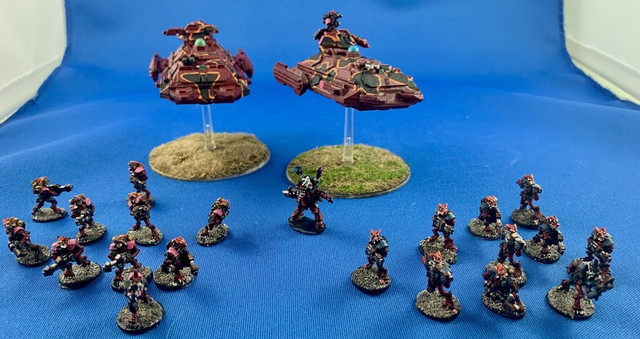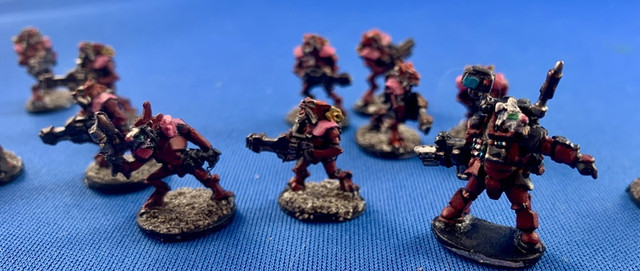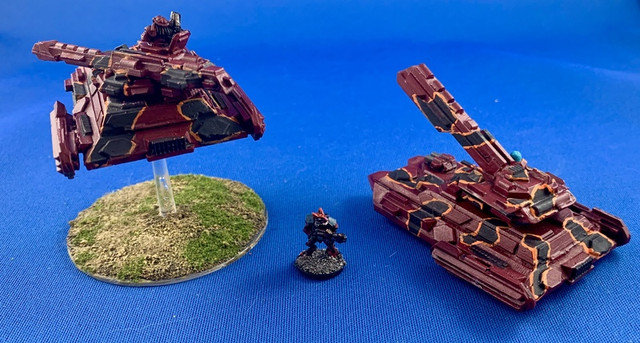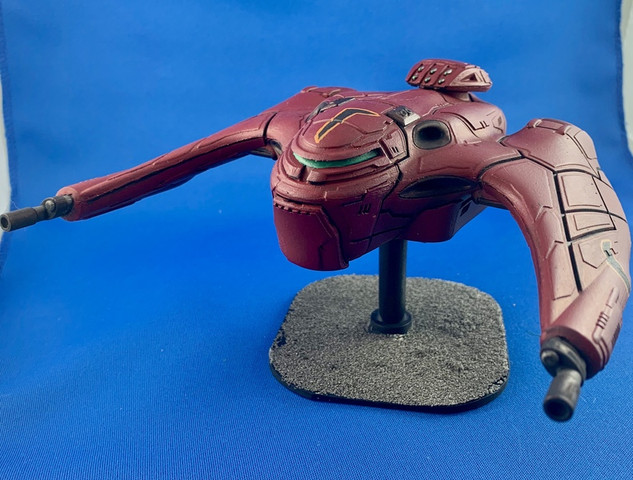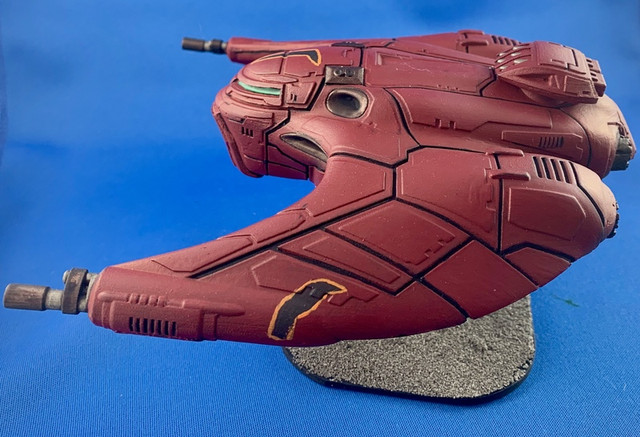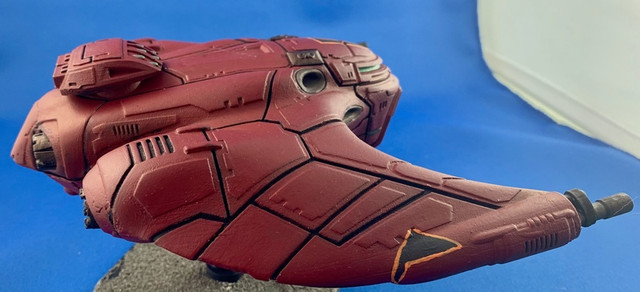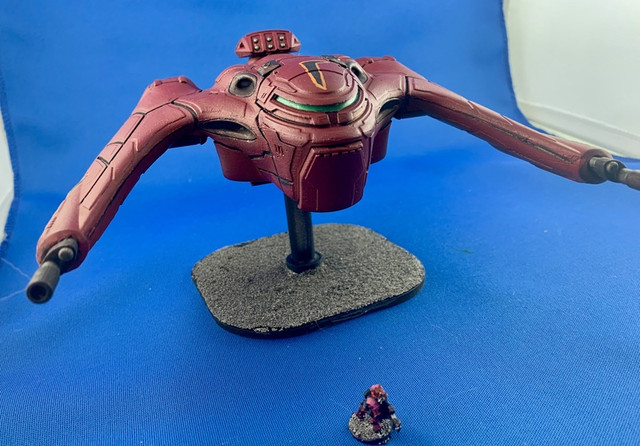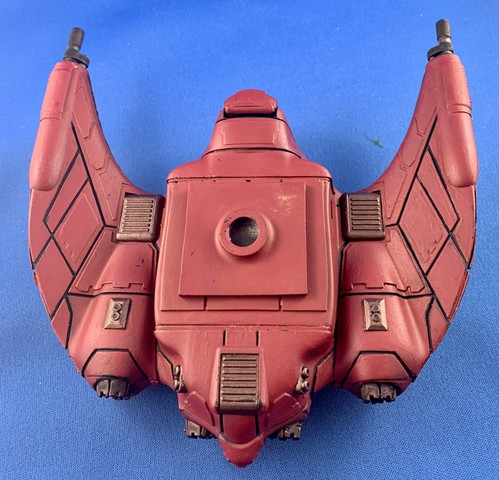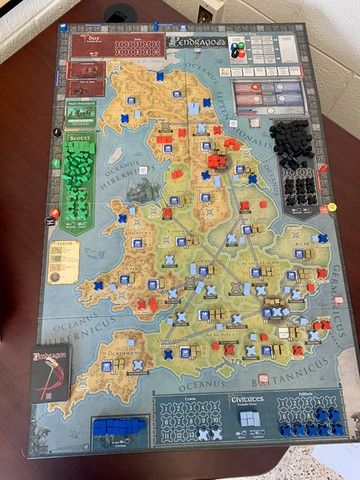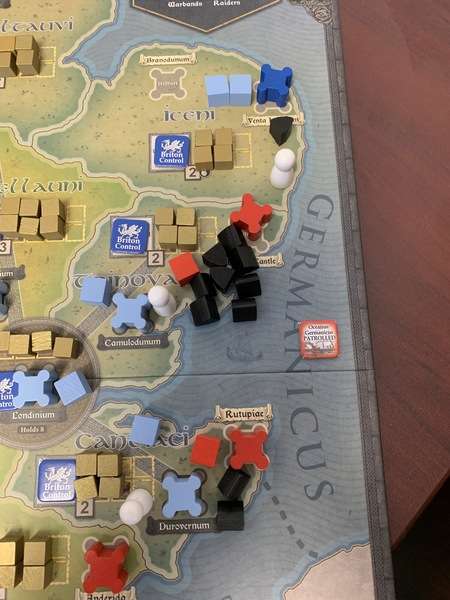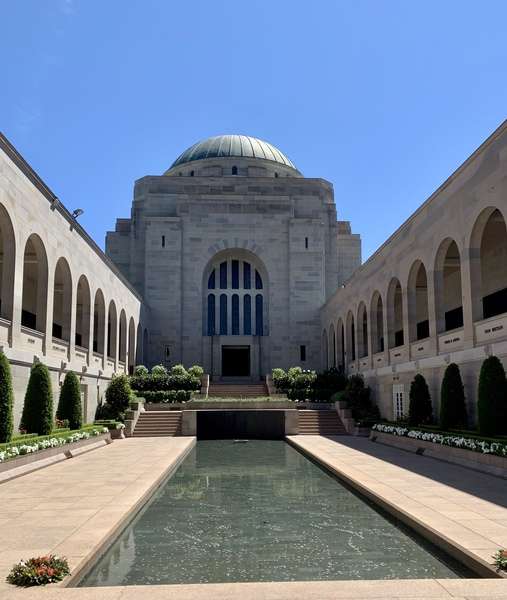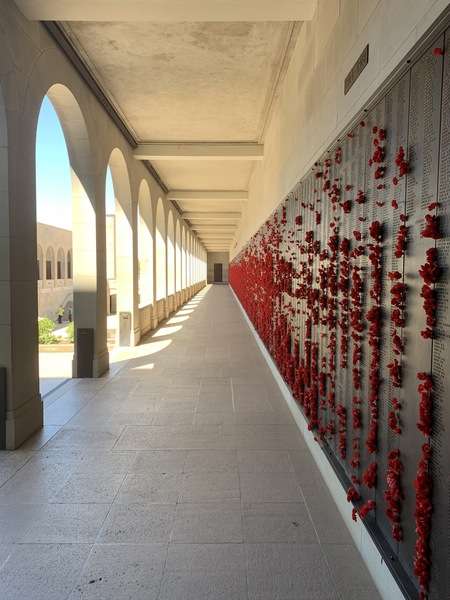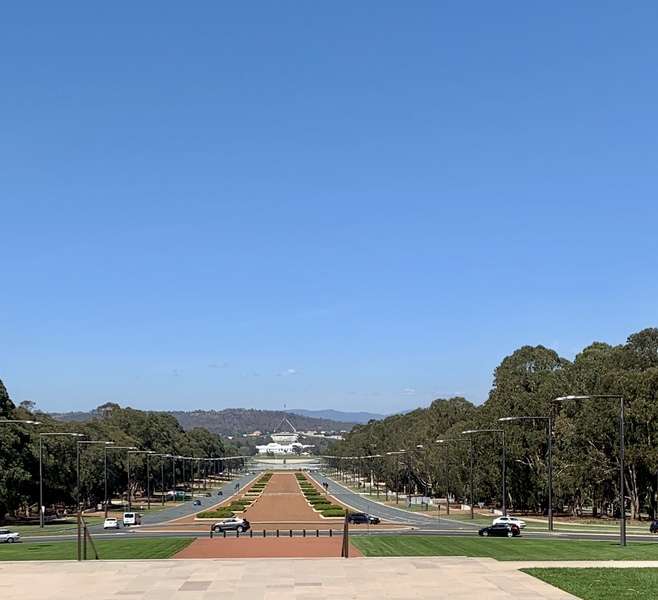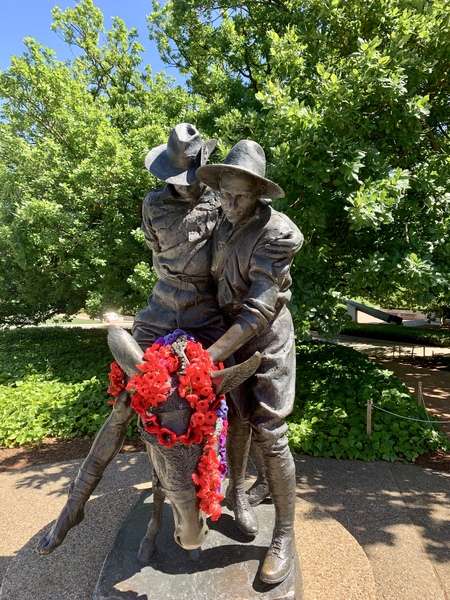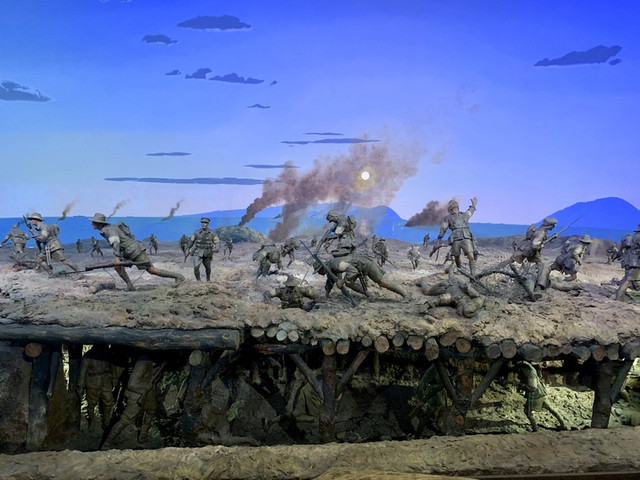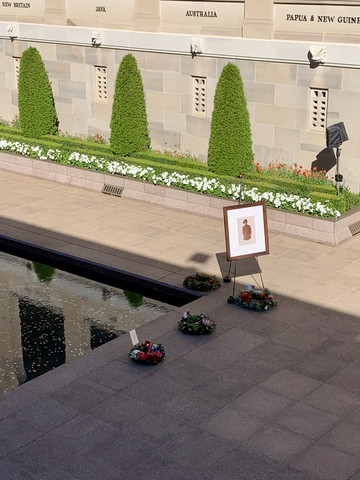Last fall as part of GMT Games' annual sale, I couldn't resist ordering their 2017 title
Pendragon: The Fall of Roman Britain. Designed by Mark Gouyon-Rety, it is one of the latest instalments in their series of COIN games, and is developed by Volko Ruhnke, the Prince of COIN.
GMT's COIN games are multiplayer simulations of political and military struggles other than traditional warfare. Since they don't use the traditional war-games hex and counter format with historical orders of battle, and have a Eurogames look to them with their many multi-coloured blocks, they aren't for some grognards. I confess I like them because of their complex and clever modelling of the historical processes - influence, population movement, and shifting allegiances - that mark many conflicts. Some years ago I made some comments
here about their Afghanistan COIN game, A Distant Plain.

So here we are in the last days of Roman Britain. The red counters are Dux, the Roman Army in the late 4th century. They have a lot of good troops and forts, and are at the start politically linked with the Civitates, the Romanized Britains (blue) who hold the towns and a variety of strongholds throughout the countryside. On the left, the green counters are the Scoti, Celtic Irish and Scottish tribes, while the black counters are the Saxons. Obviously the Scoti and Saxons want to carve up Britain between them.
As the photo shows, Pendragon is a beautiful game to look at, and is typical of GMT's high production values. A quick play by play of the first few moves follow to give you a sense of the game mechanics.
The turn sequence is card driven, as in other COIN games. Each card shows the four factions' icons in different sequences. Two factions can act on each card, starting from left to right. The card on the left is in play, and the next card is placed face up on the deck, so players often face choices on whether to act on one card or pass and wait for the next, more optimal card.
The first faction allowed to move is the Civitates. Since, while wearing my Civitates toga, I know the barbarians are coming, I decide to use the Muster Command to pay resources to place an extra militia cube (the light blue cubes) in each of the provinces marked with a white pawn. I also spend additional Resources to stockpile Wealth, which can be used for unit upgrades and the like. Might as well get ready.
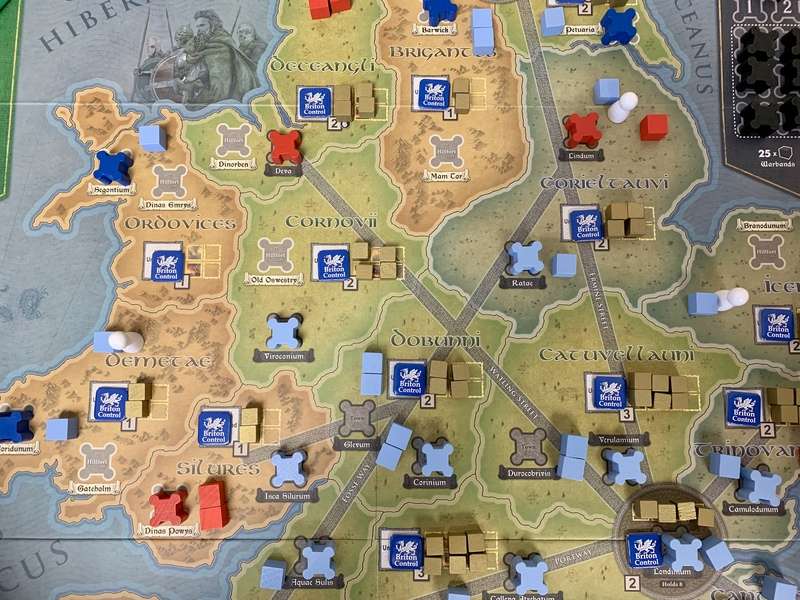
Next up on the St. Germanus card is the Dux faction, and since they are maxed out, with all their troops and forts already in play, they pass and accrue some Resource points for biding their time and harvesting their strength. Because the Dux passed, the Scoti can act, bu since the Civitates have gone first, the Scoti only have a Limited Action, meaning they can only operate in one area. They could play the shaded part of the St. Germanus event card, Papal Oversight, which would rob the Civitates of resources, but their game is all about raiding, and I want to see how the Raid mechanics work.
Each raid generates a random number of raider units, which are not as strong in battle as regular units, but are quite pesky. The Scoti get to roll 1d4 for free, but chose to spend a Renown point (Renown points measure the success/failure of the two barbarian factions) to roll an extra dice. Scoti rolls a 7, so seven raider parties descend on the region of Ordovices. The Hibernian Sea is currently unpatroled, so the raiders are cross successfully.

Wealth in Pendragon is measured by gold Prosperity/Plunder cubes. Ordovices has two, and the raiders can take a number equal to the population rating (Orodovices has pop 1) so the Scoti get a Plunder cube to try and take home - if successful they convert the Plunder to a Renown point, which the barbarian factions need to win. The only Civitates militia cube in the region has wisely retreated into the hill fort at Segontium, but the Scoti can afford to throw all those raiders at the hill fort. A multi-stage process (Escalade, painful for the attackers, then Storm, a straight exchange) follows. At the end, the Scoti lose four raiders, but eliminate the hill fort and the militia, and acquire two more Plunder for a sacked stronghold. They have three raider units left, so can carry all three Plunder. Hopefully in the next Scoti turn, the raiders can return home and convert that Plunder into three Renown points.

Since two factions have moved, the St. Germanus card is finished and the Annona card is now in play. Dux and the Saxons are the first eligible factions to move on this card. The next card, now face up on the deck, is Groaning of the Britains. Again, a faction can either chose the event on the card in play, (top version) good for them or (shaded version) bad for the others, or instead of an Event they can chose an Action, so there is always a choice on each card.
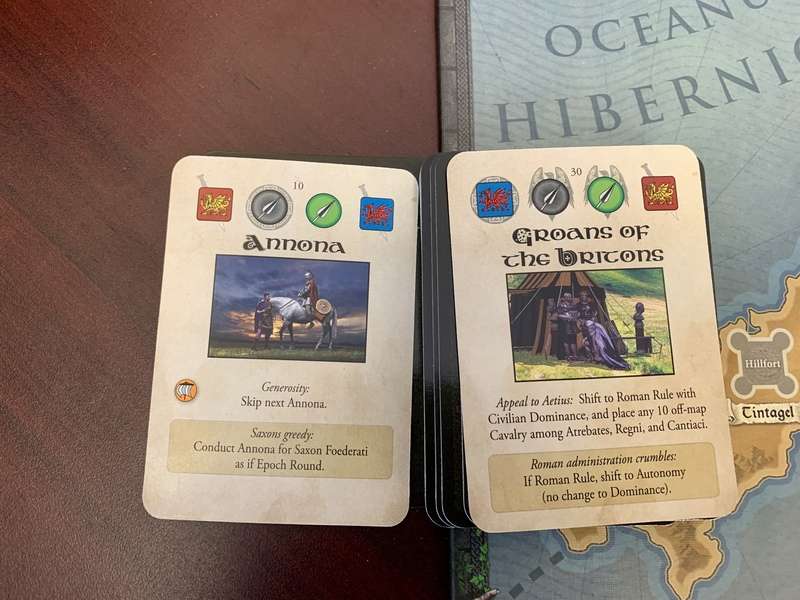
Situation at the beginning of the next card - Dux can go first. The "Annona" event isn't relevant since there are no Feoderati (barbarian bands hired by the Dux/Civitates) in play yet that need to be paid for. Dux therefore focuses on actions and could choose the Train option to reinforce, but since all its allowable forces are already on the board, there is no sense in that. Dux has two red cavalry units in neighbouring Deceangli which could use a Move action to reach Ordovices, but since the British have lost control of that region, the Dux cavalry could not bring the Scoti raiders to battle. They could do this on an Intercept move, but only if the region was under Briton control (before Fragmentation, Dux and Civitates are both treated as Britons). Getting Ordovices back under Briton control is a long-term project that Dux is willing to leave to the civilians, and besides, those two cavalry units in prosperous Deceangli are needed in case of further raids. Dux passes and collects 3 Resource points.
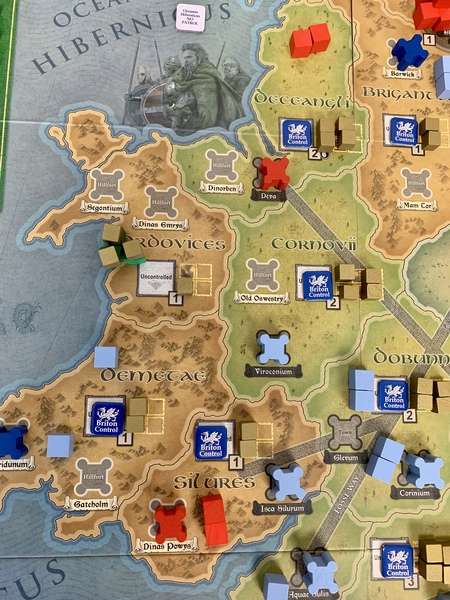
Saxons are next according to the Annona card and with my Saxon cap on, I decide to Raid in a big way. The Saxons can Raid up to three regions or cities bordering the Oceanus Britannicus or Oceanus Germanicus. They choose, from N to S, the three regions of Iceni, Trinovantes, and Cantiaci, spending 1 Renown each for Iceni and Cantiaci to roll 1d4 of Raiders and 2 Renown for Trinovanes to roll 3d4 of raiders. The result looks grim for the people of Trinovantes, with 8 raiders descending on them!
Because the Oceanus Germanuicus is partrolled and is bordered by three red Dux forts, the residue of the Roman Navy does its job and three raiders are removed from each group, which means that the Britons only have to worry about Trinovantes. The Saxons now grab Plunder equal to the population, so two Plunder cubes.
The united Britons decide to stand and give Battle, and we go through the preBattle sequence, where the Saxons elect to try and Ambush (need a 5 or 6 on 1d6) but fail their die roll. The hard hitting Dux cavalry charge first, killing two raiders, then in a simultaneous round the raiders inflict 1 and 1/2 hits, killing both Briton units, while the Militia do 1/2 hits, enough to kill 1 raider. That leaves two Saxon raiders loaded with loot, and that seems like a good if bloody day's work. Trinovantes remains Britain but is now devoid of its garrison and the Saxons, like the Scoti before them, will try to take their loot home. A dark pattern for Roman Britain is emerging.
So there are lots of things I am probably getting wrong, but that is the game so far, and I am enjoying it and the many decisions it forces on each faction. As I continue, I may try and use the "bots", the decision trees for the non-player factions, if only to learn what the optimal strategies are for them, but for now the best COA for the barbarians seems to be raid, raid, and raid some more, until the Britons are weak enough that the remaining raiders can start to take up a permanent foothold.
Blessings to you gaming!
MP

